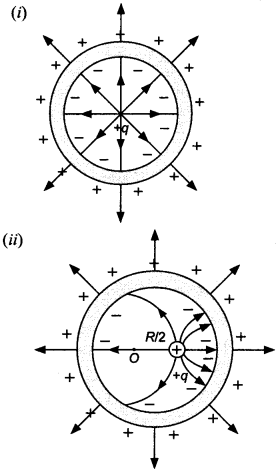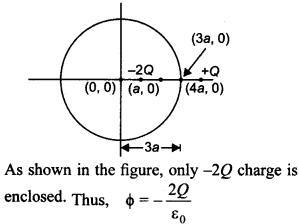Electric Charges and Fields Class 12 Physics MCQs Pdf
61. Draw the electric field lines if (i) a point charge + q is placed at the centre (ii) a point charge + q is placed at a distance R/2 from the centre.
Answer/Explanation
Answer:
Explaination:

62. What is the physical significance of electric field?
Answer/Explanation
Answer:
Explaination:
From the knowledge of electic field intensity at any point, we can readily
calculate the magnitude and the direction of force experienced by any .charge
q0 placed at that point.
63. Define the term electric dipole moment. Is it a scalar or a vector quantity?
Answer/Explanation
Answer:
Explaination:
The product of the magnitude of one of the point charges constituting an
electric dipole and the separation between them is termed as electric dipole
moment.
It is a vector quantity.
64. What is an ideal (point) dipole?
Answer/Explanation
Answer:
Explaination:
An ideal dipole is the dipole whose size (2a) is vanishingly small, and the
magnitude of electric charges constituting by it is very large, and the product,
i.e. 2aq is finite.
65. What is the value of \(\left|\frac{E_{a x}}{E_{e q}}\right|\) for a short electric dipole?
Answer/Explanation
Answer:
Explaination:

66. Two point charges +q and -q are placed at a distance d apart. What are the points at which the resultant electric field is parallel to the line joining the two charges?
Answer/Explanation
Answer:
Explaination:
(i) At any point on axial line.
(ii) At any point on equitorial line of a dipole.
67. If F is the magnitude of force experienced by a unit charge placed at a distance of 1 cm from an infinitely large charged sheet, then what will be the force experienced by the same charge placed at a distance of 2 cm from the same sheet? [HOTS]
Answer/Explanation
Answer:
Explaination:
In case of sheet of charge, the electric field is constant. Hence, F – qE
will be same irrespective of distance.
68. What is the direction of net force on electric dipole, placed in a non-uniform
electric field?

Answer/Explanation
Answer:
Explaination:
Since, the electric field at the location of charge -q is more than that of
field at charge +q. Therefore, the direction of net force will be in the
direction opposite to the direction of \(\vec{E}\).
69. When does an electric dipole placed in a non-uniform electric field experience a zero torque but non-zero force?
Answer/Explanation
Answer:
Explaination: When the dipole axis is parallel to the direction of electric
field.
70. Name the physical quantity whose SI unit is V.m. Is it a vector or a scalar quantity?
Answer/Explanation
Answer:
Explaination: The physical quantity is an electric flux. It is a scalar
quantity.
71. Define the term electric flux. Write its SI unit. [Foreign 2017]
Answer/Explanation
Answer:
Explaination:
Electric flux through an area is the product of magnitude of area and the
component of electric field vector normal to it.
![]()
72. What is a Gaussian surface?
Answer/Explanation
Answer:
Explaination:
A Gaussian surface is an imaginary closed surface in three dimensional space
through with the flux of a vector field is calculated.
73. What is the use of a Gaussian surface?
Answer/Explanation
Answer:
Explaination:
A Gaussian surface is used to determine the electric field intensity around a
point charge or charged body.
74. Why can a Gaussian surface not pass through any discrete charge?
Answer/Explanation
Answer:
Explaination:
Because the electric field due to a system of discrete charges is not defined at
the location of any charge.
75. Two charges of magnitudes -2 Q and + Q are located at points (a, 0) and (4a, 0) respectively. What is the electric flux due to these charges through a sphere of radius 3a with its centre at the origin? [AI 2013]
Answer/Explanation
Answer:
Explaination:
According to the Gauss’s theorem, the total electric flux through any closed
surface is equal to \(\frac{1}{\varepsilon_{0}}\) times, the total charge
enclosed eo by the surface.

76. Does the charge given to a metallic sphere depend on whether it is hollow or solid? Give reason for your answer. [Delhi 2017]
Answer/Explanation
Answer:
Explaination: No. Electric charge resides on the outer surface only.